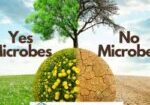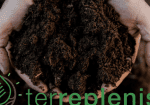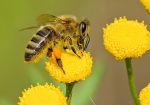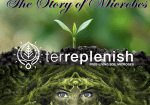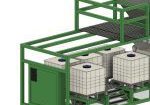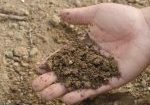Terreplenish: Winter’s Cover Crop
September 22, 2022
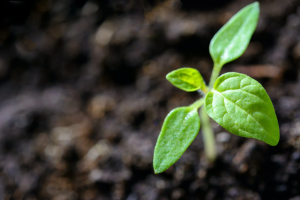
Terreplenish winter’s cover crop benefits
The garden hibernates. Dried stalks and leafless shrubs stand out against a light dusting of snow. Nature and the gardener draw a breath after summer’s frantic rush and fall’s rich harvest. Beneath the snow, the soil lies frozen in a rock-like crust. At first glance, it seems lifeless and barren. If we could look deeper, observe the rich interconnection of the soil web, we would see that while the garden sleeps, the soil dreams of spring. When we have completed our work as gardeners, replenished and protected the powerhouse of soil life, millions of organisms are eager to provide a surge of growth as weather warms. That’s where our proprietary blend of living microbes Terreplenish® comes in. Knowing what happens deep in the winter soil helps us understand why our fall gardening practices are so essential and how our product can help enhance and sustain the life of the soil through the thick blanket of cold that passes through winter months. In this article, I can only lightly touch on the vast complexity of the soil food web. I will pass over all the protozoan species, the nematodes (good and bad), and the vast range of insects and arthropods. My focus is just a sample of microorganisms and worms – the smallest and largest inhabitants of the soil.
Bacteria and Archaea
Soil microbes, like all living organisms, need food and energy. In winter, as the sun’s warmth declines, these are at a premium. Annual plants die after setting seed, while perennials reduce growth and consolidate sugars in their roots; less plant sap is available to feed carbohydrate-loving microbes. With decreased warmth and nutrients, decomposition of organic matter slows as microbes settle toward a quiescent state. Because of their simple structure, many types of bacteria can freeze without harm. Unlike more complicated organisms, bacteria have membranes that do not burst when their internal fluids turn to ice. With soil rich in humus, bacteria can hibernate through the cold weather well protected within their carbon habitats. Soil that drains well and has humus content around 10% is an ideal environment for overwintering microbes.
Some microbes are even hardier and more primitive than bacteria. These are the archaea, a relatively recent discovery in soil biology. Archaea microorganisms are possibly the most ancient living things and have been found in every known environment from Yellowstone’s hot springs to ice floes in the Arctic. Because they can live and reproduce in extraordinarily harsh ecologies, they are often called extrememophiles – lovers of the extreme. While only a few hundred types have been studied, it is probable that thousands of archaea species live in the soil. Until recently, it was thought that only certain bacteria were specialized to convert ammonia into nitrate, a process called nitrification, which is essential for plant nutrition. Scientists have found that Crenarchaeota archaea are by far the most dominant ammonia oxidizers – up to 3,000 times more abundant than bacteria. Archaea, with their extraordinarily simple cells, are still working at temperatures near 0C when other microbes are fast asleep. To promote soil life during fall and winter, I lay down compost, plant cover crops (see Cover Crops Article) and make sure to feed the soil with a deep application of Terreplenish®.
Cereal crops such as rye, winter wheat and triticale protect the soil from leaching of minerals and also help stabilize soil carbon, essential for microbes. Research shows that the population of microbes around cereal roots can actually grow during winter, generating organic nutrients ready for spring. Terreplenish® with its diverse microbial population, high in azotobacter vinelandil and bacillus subtilis, supercharges the soil and roots with microbial life. This proprietary blend of living microbes will do everything a cover crop will do, and more without the cost of added equipment and time.
Soil Fungi and Mycorrhizae Many species of soil fungi do not actively survive the winter; instead they set spores. As soon as soil temperature rises, those spores begin to sprout, sending out masses of thread-like hyphae, connecting to their preferred nutrient sources. Most fungi are beneficial to the soil food web, breaking down cellulose to produce plant nutrients and humus. Others can be noxious pests, colonizing mulch, depleting nutrients and attacking plants.
Fungal spores causing rusts, blights, wilting, molds, damping off and root rot are everywhere, floating in the air and settling in the soil. Many gardening experts suggest that the ground be rough dug in fall and weathered during winter to help rid the soil of unwanted fungi and insects. However, this is a two-edged sword. Fall digging disrupts the network of beneficial fungal hyphae, particularly those belonging to mycorrhizae. Mycorrhizae have been shown to not only strengthen plant development, but also help prevent infestation by noxious fungi. Both spores and hyphae of mycorrhizae withstand winter temperatures and, if left undisturbed, can quickly colonize plant roots in the spring. Another beneficial fungi, trichoderma, actively attack destructive fungi in the soil and on plant surfaces. It even prevents snow molds that form on lawns under snow.
Healthy winter soil, full of beneficial fungal microorganisms, defends tender spring seedlings from attack and gives a boost to early growth. Again, planting a cover crop and adding Terreplenish® to your soil is an effective way to strengthen populations of beneficial fungi. Trichoderma and mycorrhizae are found in large numbers in the soil after the cultivation of winter cereals. To support the growth of these beneficial, I add Root Web, with its 21 species of mycorrhizae and trichoderma, to my final application of Terreplenish® microbial concentrate. I seldom have problems with disease in the greenhouse. I believe that a soil well stocked with good fungi has enormous value in protecting plants from attacks of all kinds.
Worms Of all the myriad members of the soil food web, worms have the most interesting winter survival strategies. Before the soil freezes, common earthworms burrow down into the subsoil, below the frost line – as much as six feet deep. There they form a slime-coated ball and hibernate in a state called estivation. Because they are wrapped in mucous, they can survive for long periods without moisture until spring rains wake them from their slumber. Not all kinds of earthworms make the downward journey. Some lay eggs in cocoons safe in the soil, ready to hatch when conditions are right. Then they settle under leaf litter on top of the soil, where they freeze and die.
A type of Northern worm, S. niveus, has evolved an extraordinary method of making it through the winter. S. niveus worms can manufacture glycerol as a kind of antifreeze in their internal fluids. This allows them to supercool their bodies to 15C and survive even the harshest cold. In my greenhouses, I find that many worms avoid hibernating by finding unfrozen strata of soil – perhaps under a barrel of water that serves as thermal mass, or beneath a plastic bag filled with leaves. Lifting some insulating object, I often find a wriggling mass of worms when I least expect them. Terreplenish® is my preferred way of protecting all the life in the soil, including worms. Microbes are a worm magnet!
Deep mulch reduces fluctuations of soil temperature that cause problems for soil life and over-wintering plants. It also decreases the amount of freezing in the soil and conserves soil moisture. Soil life needs less water in winter than in summer, only about 15%, so watering is needed only during warm dry periods. In fact, it is often important to avoid watering mulches to reduce molds and noxious fungi. In moist warm climates, artillery fungus and molds colonize mulch, so only materials that have been hot-composted should be used. In dry climates, such as mine, raw materials – leaves, hay or straw – work well as long as they are kept fairly loose and un-compacted. I like to fluff up the mulch once or twice during the winter to keep it mold free. Plenty of compost, a smattering of cover crops, a dose of Terreplenish® and a deep covering of mulch will keep all those wonderful organisms in the soil snug and healthy. With all that life poised to spring into action, you can be sure your next growing season will exceed all your expectations.
Visit our shop at terreplenish.com/shop to grab a hold of this incredible microbial blend to ensure and enhance the richness of your soil, and therefore your crops, as it the life within it turns downward and inward to later awaken and flourish in the abundance of spring.
For 10% discount use coupon code FEN10
Related Posts
Grow Better with Terreplenish®
Proven nitrogen-fixing results from our blend of proprietary
free-living nitrogen-fixing microbes.
100% all natural and OMRI listed for organic use on:

